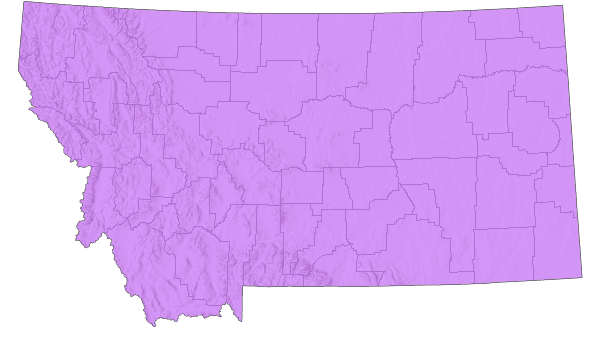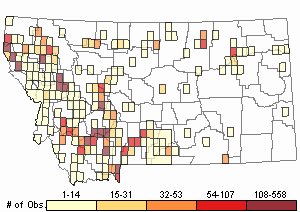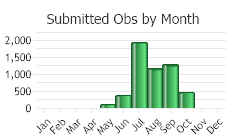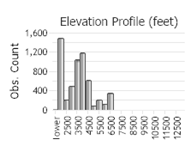View in other NatureServe Network Field Guides
NatureServe
Montana
Utah
Wyoming
Idaho
Wisconsin
British Columbia
South Carolina
Yukon
California
New York
Broad Waterweed - Elodea canadensis
Native Species
Global Rank:
G5
State Rank:
S4
C-value:
7
Agency Status
USFWS:
USFS:
BLM:
External Links
General Description
Leaves 5–12 × 1.5–2.5 mm, minutely serrate, narrowly lanceolate and opposite below to more linear and 3-whorled above. Male flowers: spathe to 15 mm long, inflated above; sepals 3–5 mm long; petals 4–5 mm long; stamens 7 to 9. Female flowers: spathe 1–2 cm long, not inflated; sepals ca. 2 mm long, purplish; petals 2–3 mm long. Capsule 5–6 mm long (
Lesica et al. 2012. Manual of Montana Vascular Plants. BRIT Press. Fort Worth, TX).
Diagnostic Characteristics
The native Elodea canadensis has dark green leaves that are often speckled with large dark cells (DiTomaso and Healy 2003). Middle and upper leaves are opposite or 3-whorled and those below the growing tips often curve slightly downward (DiTomaso and Healy 2003). Leaves are often relatively longer and narrower in comparison to exotic species. The mid-vein of each leaf is smooth on its underside (DiTomaso and Healy 2003). Roots are more wiry when compared to Hydrilla verticillata and Egeria densa.
The exotic species of Hydrilla verticillata also have whorled leaves, but in groups of 3-12 that are 6-20 mm long and 1-4 mm wide (DiTomaso and Healy 2003). Leaves below the growing tips are often curved downward (DiTomaso and Healy 2003). The mid-vein of each leaf is smooth or minutely toothed on its underside (DiTomaso and Healy 2003).
The exotic species of Egeria densa also has whorled leaves, but in groups of 3-8 that are 15-40 mm long and 2-5 mm wide. The mid-vein of each leaf is smooth or minutely toothed on its underside (DiTomaso and Healy 2003).
Species Range
Montana Range
Range Descriptions

 Native
Native
Range Comments
Throughout most of temperate North America (Lesica et al. 2012. Manual of Montana Vascular Plants. BRIT Press. Fort Worth, TX).PLACEHOLDER (field is currently blank)
Observations in Montana Natural Heritage Program Database
Number of Observations: 6021
(Click on the following maps and charts to see full sized version)
Map Help and Descriptions
Relative Density

Recency



 (Observations spanning multiple months or years are excluded from time charts)
(Observations spanning multiple months or years are excluded from time charts)
Habitat
Reproductive Characteristics
Axillary buds occur at nodes, at about 10 cm intervals (DiTomaso and Healy 2003).
Stewardship Responsibility
References
- Literature Cited AboveLegend:
 View Online Publication
View Online Publication Lesica, P., M.T. Lavin, and P.F. Stickney. 2012. Manual of Montana Vascular Plants. Fort Worth, TX: BRIT Press. viii + 771 p.
Lesica, P., M.T. Lavin, and P.F. Stickney. 2012. Manual of Montana Vascular Plants. Fort Worth, TX: BRIT Press. viii + 771 p.
- Additional ReferencesLegend:
 View Online Publication
View Online Publication
Do you know of a citation we're missing? Culver, D.R. 1994. Floristic analysis of the Centennial Region, Montana. M.Sc. Thesis. Montana State University, Bozeman. 199 pp.
Culver, D.R. 1994. Floristic analysis of the Centennial Region, Montana. M.Sc. Thesis. Montana State University, Bozeman. 199 pp. DiTomaso, J.M. and E.A. Healy. 2003. Aquatic and riparian weeds of the West. Regents of University of California, Division of Agriculture and Natural Resources, Publication 3421.
DiTomaso, J.M. and E.A. Healy. 2003. Aquatic and riparian weeds of the West. Regents of University of California, Division of Agriculture and Natural Resources, Publication 3421. Garrett, P.A. 1983. Relationships between benthic communities, land use, chemical dynamics, and trophic state in Georgetown Lake. Ph.D. Dissertation. Bozeman, MT: Montana State University. 136 p.
Garrett, P.A. 1983. Relationships between benthic communities, land use, chemical dynamics, and trophic state in Georgetown Lake. Ph.D. Dissertation. Bozeman, MT: Montana State University. 136 p. Lesica, P., M.T. Lavin, and P.F. Stickney. 2022. Manual of Montana Vascular Plants, Second Edition. Fort Worth, TX: BRIT Press. viii + 779 p.
Lesica, P., M.T. Lavin, and P.F. Stickney. 2022. Manual of Montana Vascular Plants, Second Edition. Fort Worth, TX: BRIT Press. viii + 779 p.
- Web Search Engines for Articles on "Broad Waterweed"





